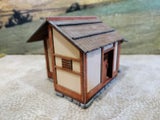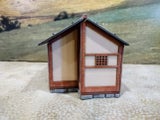- Store
- >
- Laser-cut Kits
- >
- Feudal Japan
- >
- Tea House
Tea House
SKU:
FJ-29
$15.50
$15.50
Unavailable
per item
Detailed building kit for 28mm figures (1:56 scale)
Laser cut 3mm and 1.6mm HDF, chipboard
Laser engraved details
Removable roofs for easy access of the interior
Moving sliding doors
Kit supplied unassembled and unpainted
Measures approx. L 4-1/4” x W 3-1/4” x H 3-1/8” / 110mm x 85mm x 80mm
Figures, plants, and accessories are NOT included!
Detailed instructions are available for download at www.thingsfromthebasement.com
Traditional Japanese tea houses (chashitsu) are usually small, simple wooden buildings. They are located in the gardens or grounds of private homes. Other common sites are the grounds of temples, museums, and parks. Tea houses first appeared in the Sengoku period (mid-15th century to early 17th century), a time in which the central government had almost no practical power, the country was in chaos, and wars and uprisings were commonplace. Tea houses were built mostly by Zen monks or by daimyos, samurai, and merchants who practiced tea ceremony. They sought simplicity and tranquility – central tenets of Zen philosophy.
The tearoom has a low ceiling and no furniture: the guests and host sit on the floor. All materials used are intentionally simple and rustic. Besides the guests' entrance (nijiriguchi, which is translated as “crawling-in entrance"), there is at least one other entrance for the host, named sadoguchi, that leads to the mizuya (preparation area). Entering the tearoom while bending like this, is a symbol that inside, during the tea ceremony, all guests are equal, regardless of their social status.
The tearoom has a low ceiling and no furniture: the guests and host sit on the floor. All materials used are intentionally simple and rustic. Besides the guests' entrance (nijiriguchi, which is translated as “crawling-in entrance"), there is at least one other entrance for the host, named sadoguchi, that leads to the mizuya (preparation area). Entering the tearoom while bending like this, is a symbol that inside, during the tea ceremony, all guests are equal, regardless of their social status.













